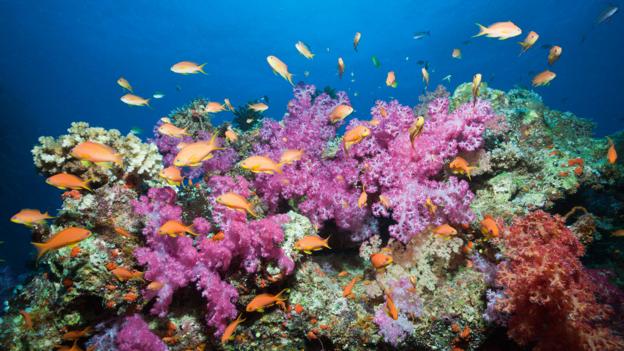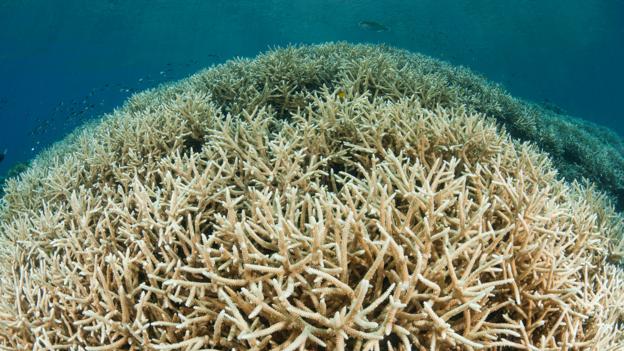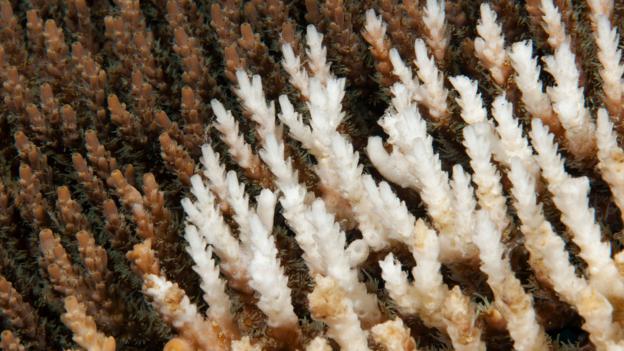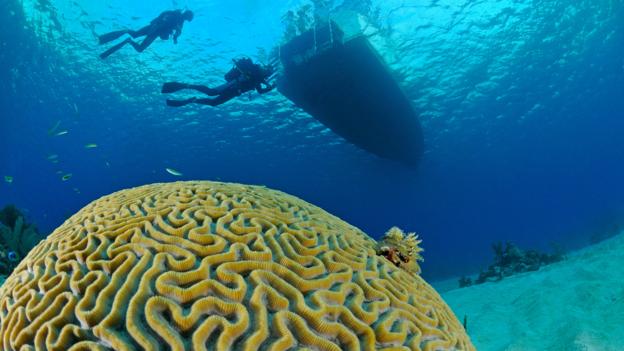Ruth Gates saw it time and time again. While surveying coral reefs of Caribbean in the late 1980s, she noticed that many corals were clearly stressed, sapped of their colour. Some faded to skeletal white.
The trigger was always a sudden surge in ocean temperature. Some corals reacted by ejecting the algae that live within their tissues and usually provide them with colour and nutrition. The process is aptly known as coral bleaching.
But it was not the bleached corals that piqued Gates's curiosity. It was the fact that the corals growing next door to the death-white colonies were often still colourful, vibrant and healthy.
Separated by just a few centimetres, how could two corals be worlds apart when it came to their response to warming?
The very fact that there were such dramatic differences has ultimately seen
Gates and her longtime colleague
Madeleine van Oppen of the Australian Institute of Marine Sciences come up with a daring but controversial plan to save the planet's coral reefs.
Their idea? Protect corals from rapid climate change by artificially speeding up their evolution.
If they are successful, it is not just the corals themselves that will benefit. Corals provide physical and ecological support for a third of all marine life. This makes them what ecologists term "keystone species". Their health is vital for the wellbeing of countless other species.
That includes humans. A quarter of fisheries are intimately linked to corals reefs, where fishes flourish, breed, and feed.
Burning fossil fuels on land has infused the air with atmosphere-warming carbon dioxide
In the Pacific Islands, for example, 70% of the animal protein in human dietshails from the reef. They also provide coastal human communities with natural protection from tsunamis and sea level rise.
Put simply, we need corals. And that means we may well need Gates and van Oppen's plan to succeed.
Corals are dying worldwide. Since 1950, for example, an estimated 19% of corals have been lost – poof, gone. Today, nearly a third of all reef-building species are threatened with extinction.
The reason? Dynamite fishing and trawling certainly play their part, devastating through destruction and converting once rich ecosystems into underwater deserts. But the principle culprit is our rapidly changing world.
Burning fossil fuels on land has infused the air with atmosphere-warming carbon dioxide. The oceans soak up not only that heat but also a large proportion of the carbon dioxide– which reacts with water to form a weak acid. It is a two-pronged attack on aquatic life, and the defences of many corals simply are not strong enough.
But some corals may be stronger than others. Although sessile, anchored to the seabed, a coral is not a solitary animal – far from it.
We now have to intervene in a really proactive way
Inside and surrounding its tissues is a menagerie of microscopic organisms. As well as the algae that thrive within their tissues, providing their hosts with food in return for a safe place to live, bountiful bacteria cover their outer surfaces.
"Corals are crazy," says Gates, who is now the director of the Hawaii Institute of Marine Biology. "They're fascinatingly complex organisms."
Not all partnerships are created equal, however. There are myriad varieties and combinations of algae and bacteria associated with different corals, each providing distinctive benefits to their host.
By identifying the most profitable associations, Gates and van Oppen wondered whether they could provide aid to ailing reefs around the world, seeding them with corals that last. "We have pushed the [eco]system too far," says Gates, "And we now have to intervene in a really proactive way."
"It's a really good idea," says
Mary Hagedorn from the Smithsonian Institution, who studies corals in Hawaii. "I just wish it had been started 10 years ago. At the moment, it just feels like sand is falling through our fingers."
The bleaching of corals is not a recent phenomenon. These denizens of shallow seas have faced the stress of warming oceans off and on for millions of years, sneezing out their algae each time as if stricken with the flu.
We're not slowing down our carbon dioxide emissions. If anything, it's just going right on up
The problem is not that bleaching occurs. It is that bleaching is now occurring at an unprecedented rate.
Before 1980, for example, bleaching was relatively unheard of. Every few decades the corals would be stressed, fade to pale, and then quickly regain their algae, their colour, and their wellbeing. Between 1980 and 1998, there were 370 regional bleaching events recorded.
But 1998 marked the first global bleaching event. It killed 15% of corals. Between 1998 and 2010, there were more than 3,700 regional bleaching events.
"They've gone up by a factor of ten," says Hagedorn. "And we're not slowing down our carbon dioxide emissions. If anything, it's just going right on up."
A species of animal can change which genes are switched on and off, and for how long
Last year, the El Nino pulse in the southern Pacific led to a worldwide bleaching event with an estimated 97% of corals affected to some degree. If the algae do not return, corals can starve.
But they are not completely helpless. "There is versatility in corals that we undervalue," says Gates. Given time, they can acclimatise to stressful conditions.
"All [corals] have the ability to step-up their physiology, to harden themselves," says
Steve Palumbi from Stanford University. Along the coast of the Samoan island of Ohu, where he works,
tabletop corals that live in waters that vary in temperature by as much as 6C everyday are far more resistant to stress – holding on to their algae for longer – than corals from more stable locales.
Why the difference? It all boils down to their DNA.
Even though they harbour the same genes, a species of animal can change which genes are switched on and off, and for how long. Known as epigenetics, such molecular dimmer switches can allow an organism to adapt to changing conditions within its own lifetime, without altering the genetic code itself.
We expose them to what I call environmental treadmills
In the Samoan corals, for example, out of 16,728 genes investigated, the activity of 74 changed significantly when placed in elevated temperatures.
Although many have unknown functions, some produce so-called heat shock proteins that stabilise vital chemical processes, binding to other proteins that have been misshapen by stress and bending them back into working order. "They're like protein chiropractors," says Palumbi.
In their labs, Gates and van Oppen are ramping up the temperature of their captive corals – each collected from the reef on Coconut Island in Hawaii or from the Great Barrier Reef – to try to find those with the beneficial epigenetic traits.
"We expose them to what I call environmental treadmills," Gates says. "It's all along the lines of what doesn't kill you makes you stronger."
But simply identifying resilient corals is not enough. Once the temperature cools again, the epigenetic changes are lost. "It's kind of an easy come, easy go problem," says Palumbi. "Corals can respond to their environment adroitly, but it can go both ways."
That might not be true for their offspring, though. As is well established in plants and invertebrates, epigenetic changes can be inherited from their parents and, crucially, remain stable throughout their lifetimes.
It's really about: can we raise the resilience of corals?
"But it's never been shown in corals," says Palumbi. It is this that Gates and van Oppen hope to change with their work. From opposite sides of the world, the two researchers are currently exposing 'pregnant' corals to projections of global warming in their aquaria and assessing whether any epigenetic pointers are passed on.
If they are, such molecular hand-me-downs would help form a generation of super-corals, for more robust to the problems of climate change than most corals in nature. Both Gates and van Oppen envision a day when corals are exposed to bursts of heat or acid stress, either in the lab or directly on the reef, engendering future generations with a genetic toolkit most fit to the conditions they are likely to face.
At this stage, though, "it's not about how will we do it or how will we use these stocks", says Gates. "It's really about: can we raise the resilience of corals?"
The jury is still out on that one. But, even if epigenetics is limited to just one lifetime, there are other ways to help the corals.
When it comes to algae, corals are very picky. "Who they partner with is critically important," says Gates.
Corals are short-sighted; more food now is better than the possibility of longevity
Some algae provide more food than others. Some are better at boosting the growth of juvenile corals. And a select few are particularly hardy, remaining within the corals tissues even when their host is stressed.
This opens up an opportunity. "What if we could select those unions that are extremely robust in the face of stress?" Gates asks. A group called Clade D algae, for example, includes the most stress-tolerant varieties of all.
One problem: corals tend not to like Clade D. Even though they would benefit in the long run from a more stable partnership, corals prefer Clade C algae, which are better food factories. Corals are short-sighted; more food now is better than the possibility of longevity.
van Oppen aims to provide them with both. In her lab at the National Sea Simulator in Townsville, Australia, she hopes to make the best food factories more tolerant to stress. The premise is simple: subject Clade C algae to elevated temperatures and acidity, and only re-grow those that survive or thrive.
Corals are like inside-out human guts
By repeating this process – re-culturing the winners and preening the population of the losers – any mutations in the algae that confer greater stress tolerance are passed on and stabilised.
It is an example of artificial selection, a process our species has used for thousands of years. It is so effective that it can turn an unappetising blade of grass into some of the most valuable food crops known today. It can also change a ferocious wolf into a yappy West Highland Terrier or an adorable Labrador.
But can it turn Clade C algae into a long-time partner? Early indications are promising.
"We have preliminary results that suggest that it might be a very good approach," says van Oppen. "We don't really know if the changes are genetic or epigenetic but what really matters for us is that they are stable."
That is on the inside. But, in addition to their algal tenants, corals are covered in a lot of slimy mucous, teeming with bacteria. "Corals are like inside-out human guts," says Gates. "And those microbes can serve you or they can kill you."
By inoculating coral larvae with different bacterial communities, Gates and van Oppen hope to find out which are best suited for increased temperatures and acidity.
Many others look like a cross between a living rock and lump of brain
"No one's looked at how the microbiome [the community of bacteria associated with an organism] impacts corals from early life stages," says van Oppen. "That's what we're trying to find out."
The importance of the microbiome is becoming more and more apparent in other animals. "We're now recognising in almost every organism that we look at that, the microbiome is sort of ruling the world," says Gates. "And in human health it is particularly profound."
Although a select few cause harm, the majority of bacteria living within our guts are of incalculable worth to our health. They digest our otherwise-indigestible food, influence our weight, shape our susceptibility to disease, and even influence our moods and behaviour.
We are just beginning to understand, and appreciate, our own microbiome. How, then, can we begin to help the 4,000 or so species of hard coral species, each with their own biological idiosyncrasies and preferred microbial lodgers?
Although incredibly diverse, corals can be divided into five or six groups, or ecotypes, each with similar life traits.
Some grow rapidly. Others can take decades to become established on the reef. There are species that form delicate branches, reaching up to the sunlight. And many others look like a cross between a living rock and lump of brain.
It's anathema to many people because they like to think of the oceans as wild
Casting a wide net, Gates and van Oppen have sampled each ecotype. With at least one representative from each, they can assess which treatments work for each of their varying life traits.
"If we can understand how each of those ecotypes respond to the types of manipulations that we're doing, then that will then help us to translate it to other places," says Gates. "Potentially all the species in that ecotype will also do the same thing."
One ecotype, for instance, might respond remarkably well to a specific algal transplant. Others might benefit from the addition of particular bacteria to their microbiome.
It is not a watertight solution, as every coral is likely to have its own particular preferences. But it is the best rapid solution we have to a bad problem.
Assisting with the evolution of wild animals is naturally controversial. It does not carry quite the same stigma as genetic modification, but both practices can be pigeonholed into the narrative of 'Playing God'. Each coral will bear the imprint of human help.
Only the very strongest will survive, reducing reefs to shadows of their former assemblages
"It's anathema to many people because they like to think of the oceans as wild," says Hagedorn. "But that's the way all our parks and our fisheries work."
Plus, "assisted evolution" is not particularly unnatural when you really think about it.
"We're doing what nature does," says Gates. "We're just trying to accelerate it so that corals can keep up. And we'll try to see how far we can push it because, frankly, we've already pushed the planet to accelerate at the rate at which it is warming."
Other critics, meanwhile, claim that the diversity of corals will be reduced if such methods are put into practice. Only the very strongest will survive, reducing reefs to shadows of their former assemblages.
"I agree," says Gates, "but you've also got to think about what will happen if we do nothing." A coral reef with reduced diversity is better than no reef at all, particularly considering all the benefits that they bring.
If we can help, we should
The leitmotif of this dystopian coral-free world is depletion. Marine life and fisheries would collapse. Natural defences against hurricane-fuelled waves and tsunamis would be lost. Land would be eroded, with some islands sinking into the surrounding seas, giving rise to ecological refugees looking for new places to live. "That's the big picture," says Gates. "It is just a recipe for disaster."
Simply cordoning off damaged reefs can relieve some of the pressures from human settlements and fishing. This has been done in the past with Marine Protected Areas (MPAs), the aquatic version of National Parks. But MPAs cannot protect reefs from the sea of change that surrounds them.
"If we can help, we should," Gates says. "I want to see the decline in coral reefs start to stabilise while we attend to the much bigger issue of mitigating fossil fuel burning."
This is it. This marks the first attempt at human beings enhancing evolutionary survival traits in endangered species. This what we were evolved for, to be the Brains of the planet's life-supporting eco-systems, our final role in human evolution. This is what all the cancerous diseases are about, to get us motivated to learn how to genetically modify dna of threatened species. This is what all the DNA studies are about in the long run, Finding out ways to fix broken, disabled, diseased DNA so we not only can heal ourselves but do what's necessary to protect endangered species while we struggle to get control back over our industrial polluters protected by government laws favoring profits over life systems.
 Reuters
Reuters







 Last week it was reported that publishing giant McGraw-Hill Education
Last week it was reported that publishing giant McGraw-Hill Education 

